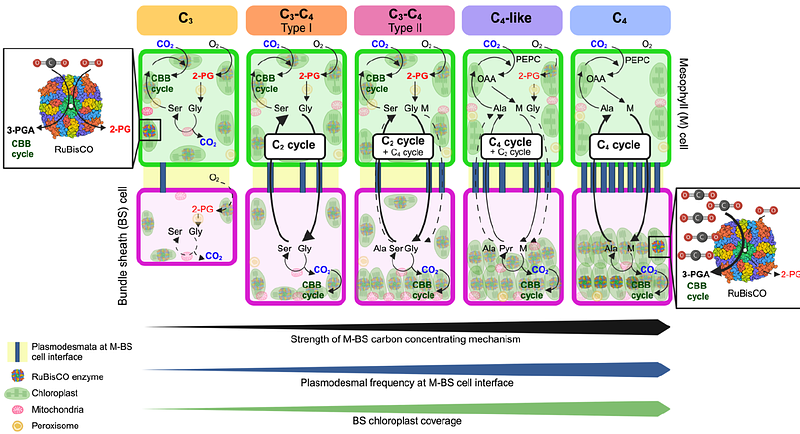Stepwise increase in plasmodesmata during C4 evolution in Flaveria

Stepwise increase in plasmodesmata during C4 evolution in Flaveria
Aleksejeva, K.; Schreier, T. B.
AbstractPlant cells are interconnected via plasmodesmata that enable the exchange of mobile molecules such as metabolites between neighbouring cells. In leaves of plants that conduct C4 photosynthesis, carbon fixation is separated between mesophyll (M) and bundle sheath (BS) cells, and the shuttling of metabolites between these cells is thought to be crucial for running the carbon concentrating mechanism. Higher numbers of plasmodesmata for metabolite exchange between M and BS cells have been observed in multiple lineages of C4 plants, but how this increased cell-to-cell connectivity developed in the context of C4 evolution is not understood. Here, we examined plasmodesmata in Flaveria species, including C3, C3-C4 intermediate, C4-like and C4 species to represent an evolutionary gradient. Using electron microscopy, we found two distinct stepwise increases in plasmodesmata frequency along this gradient. C3-C4 intermediate species had ~3 fold more plasmodesmata than C3 species, and C4-like and C4 species had >6-fold increases relative to the C3 species. In the first step between C3 and C3-C4 intermediate species, plasmodesmata numbers were higher in the intermediate species, but equal in frequency between M-M and M-BS cell interfaces. However, in a second step between C3-C4 intermediate and C4-like/C4 species, the increase in plasmodesmata formation was predominantly observed at the M-BS cell interface, where C4/C3 acid (malate/alanine) shuttles are active. The higher physical cell-to-cell connectivity along the evolutionary gradient occurred without significant changes in BS cell size, but coincided with the formation of increased chloroplast area/coverage in BS cells of C4 species. Thus, we propose that high cell-to-cell connectivity may facilitate 'C2 metabolism' in the C3-C4 intermediate species, which also requires metabolite transfer between cell types (e.g. glycine shuttle), but full polar enrichment of plasmodesmata at the M-BS interface accompanies C4 metabolism. Overall, our work provides new insight into the stepwise development of cell-to-cell connectivity along the evolutionary trajectory of C4 photosynthesis.